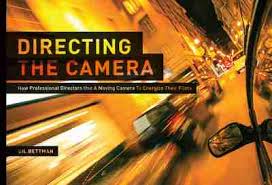Attention filmmakers! Author of “Directing the Camera”, Gil Bettman, is a guy who knows what he is talking about. He has been in “the business” of making movies and TV shows in Hollywood for many years and in his new book he shares some of what he has learned. To understand the book you first must understand what “Directing the Camera” means. Anybody who has ever shot a film, a documentary video or even filmed a home movie with the family understands “directing the talent”. IE your actors, actresses or in the case of a home movie your Aunt Ethel. Directing is quite simply telling the person who is being recorded what to do. Examples of directing talent include “Pick up the knife, take three steps and stab the bad guy” or “Stop near the window, pause, and listen to the wind howl” or in the case of Aunt Ethel “Blow out the candles but make sure your dentures don’t land in the frosting”.
Directing the camera is essentially the same thing except now the camera angles and motion becomes part of what makes the scene interesting. In the above examples perhaps the camera is stationary but now we are going to add camera movement and that movement needs to be thought out and communicated to the actors and crew. Directing the camera!
Bettman does a great job in his book “Directing the Camera”. It is broken into three parts. In part one there is only one chapter called “The Importance of Directing the Camera”. He discuses just that. It is only a few pages. Part two and three are the meat of this book. Part two is called ”Shooting dialog sequences with a moving camera”. He goes into great detail on how to move your camera during what, in many films, become boring talking head scenes. Using examples (yes there are lots of pictures) from real movies you will learn how to block your actors and camera. Indie filmmakers really need to pay attention to this section. It is gold. Shooting your master shot right up to doing the closeups is covered here.
Part three is called “Directing Action Sequences”. If you have ever watched a low budget film with an action scene that seems to drag and is downright boring that scene was shot incorrectly. It may have great acting, a cool car and great location but if the camera moves are not in the scene then that scene will suck. I use the example of indie films because they seem to be the movies that lack the extra push this book offers to the director.
After checking this volume I feel the driven and enthusiastic directors of these low to no budget films are who will benefit the most from this book. Anyone who shoots a film, web series or any other type of video that needs action will also gain a ton of knowledge. With that being said I believe even a seasoned director can still learn from it. Sure there is some stuff that I’m sure they already know in here but there are also some real gems that even a pro may not have dreamed to use. This is the stuff that the pros are using in the big hollywood blockbusters and it is available for you to learn without spending thousands of bucks on film school.
For the more advanced filmmaker Bettman has a section where he discuses lens choice. Lens choice can make a good scene great because every lens creates a different feel in a scene. lenses create various illusions of speed depending on what the subject is and how wide or narrow the lens is. Lots of detail and examples here too.
Bottom line. Great book with lots of pictures and drawings to back up the text. A wealth of knowledge packed into 177 pages.
Rating: 8/10 – Bring your film to life!
Buy “Directing the Camera” by Gil Bettman

